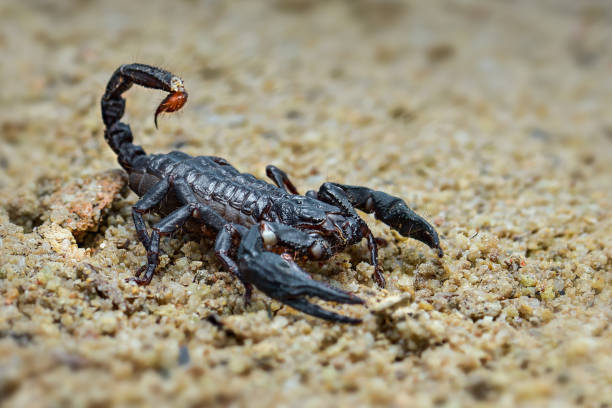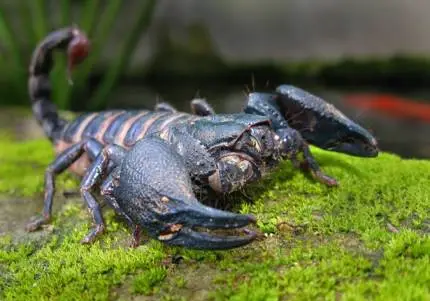The Asian Forest Scorpion is a fascinating and terrifying monster, yet many people find them intriguing enough to keep as pets. Native to the humid jungles of Southeast Asia, these scorpions are recognized for their huge size and stunning black bodies. Although they may look menacing, they may be a fantastic addition to any bug enthusiast’s collection.
This book will examine all you need to know about the Asian Forest Scorpion, including its habitat, nutrition, care, and much more. You’re at the ideal place if you’re intrigued about maintaining one or simply learning more about these scorpions.
What is an Asian Forest Scorpion?
The Asian Forest Scorpion (Heterometrus spp.) is a species found in tropical climates, mainly in nations like India, Sri Lanka, Malaysia, Thailand, and Vietnam. It is one of the biggest scorpions in the world, with adults reaching up to 5-6 inches in length. Despite their terrible look, their venom is not particularly hazardous to humans, yet it can produce discomfort like a bee sting. In the wild, they have natural predators such as birds, small animals, and other bigger scorpions.
Wildlife Habits, Habitat, and Diet of the Asian Forest Scorpion

The Asian Forest Scorpion flourishes in the humid, tropical rainforests of Southeast Asia, notably in nations like India, Sri Lanka, Malaysia, Thailand, and Vietnam. These scorpions are nocturnal and prefer dark, damp locations such as behind rocks, logs, and dense foliage. They are quite territorial and generally found alone, protecting their burrows or hiding locations ferociously. The native habitat of the Asian Forest Scorpion is characterized by high humidity (75-80%) and warm temperatures ranging from 75-85°F (24-29°C). In the wild, they graze on a range of invertebrates including crickets, beetles, and even small vertebrates like lizards or frogs. Their enormous pincers are their principal hunting gear, used to grab and crush prey. They are well-adapted to thriving in the damp, tropical habitats, where their black, glossy bodies blend with the forest floor, helping them evade predators and ambush prey.
If you wish to keep one as a pet, you need to emulate its natural surroundings. A terrarium with wet substrate and a temperature of 75-85°F (24-29°C) would be great. Make sure the humidity is about 75-80% by spraying the cage periodically.
Behavior and Temperament
Despite their fearsome look, Asian Forest Scorpions are more defensive than aggressive. They are nocturnal species, more active at night, and spend their days lurking in burrows or beneath rubbish. Understanding their behavior and temperament is crucial to appropriate ownership.
Interaction with Humans
Although they carry venom, the sting of an Asian Forest Scorpion is not lethal to humans unless you are allergic. Their principal defense is their huge pincers which they utilize to capture and crush victims.
Handling should be minimized since it might stress the scorpion. If you must handle one, use long tongs or forceps to prevent getting stung.
Diet of the Asian Forest Scorpion
In the wild, Asian Forest Scorpions prey on insects including crickets, beetles and even tiny lizards or frogs. They are opportunistic eaters, meaning they will eat whatever they can capture. When fed in captivity, their food should mostly consist of crickets, mealworms, and roaches.
Feeding Tips
Feed your scorpion once or twice a week depending on size and age. Make sure the insects you provide are gut-loaded, meaning they’ve been fed good food to pass on to your scorpion.
Remove any uneaten prey after 24 hours to avoid the cage becoming soiled or attracting additional pests.
How to Care for an Asian Forest Scorpion

Caring for an Asian Forest Scorpion involves attention to detail, from setting up the correct habitat to temperature and humidity management and a regular feeding schedule. Here are the fundamentals to keep your scorpion healthy and happy and to remind you of the dedication and responsibility that comes with pet ownership.
-
Enclosure Setup Size: One scorpion per 10 gallon terrarium. Make sure the tank has a sturdy lid; scorpions are terrific climbers.
-
Substrate: Use coconut fiber, peat moss or both as a substrate. It should be at least 3-4 inches deep for burrowing.
-
Hiding locations: Provide various hiding locations with rocks, bark or hollow logs.
-
Humidity: 75-80% humidity. Mist the enclosure regularly with water.
Temperature
75-85°F. Under-tank heater or heat light. Not in direct sunlight. Too hot. Too quick.
Lifespan and Molting
The usual lifespan of an Asian Forest Scorpion is roughly 5-8 years. Like other arachnids, they develop by molting and shedding their exoskeleton as they age. They become more fragile at this period, therefore avoiding touching or upsetting them is vital. Molting is a process when the scorpion loses its old exoskeleton and develops a new one. Signs that your scorpion is preparing to molt include diminished activity, refusing food, and spending more time in hiding.
Molting Signs
-
Reduced activity
-
Refusing food Spending more time in hiding
-
After molting, your scorpion’s new exoskeleton will be soft and requires time to solidify, so give it room.
Read Also: 5 Ways to Support Fireflies in Your Yard
Common Health Issues
While Asian Forest Scorpions are very durable species, they can nevertheless suffer from a few health concerns. These difficulties frequently develop from inadequate confinement conditions or incorrect food.
Common Issues
-
Dehydration: Keep humidity levels up and give a shallow water dish.
-
Stress: Overhandling or loud noises can stress scorpions. Minimise interaction and keep the cage silent.
-
Parasites: Keep the enclosure clean to prevent mites.
-
Some questions concerning the Asian Forest Scorpion

Is it safe to keep an Asian Forest Scorpion as a pet?
It is typically safe to keep an Asian Forest Scorpion as a pet but precautions are needed. They are not aggressive and only sting if they feel threatened. Their poison is not lethal to people but can hurt like a bee sting. With the correct care and a secure, sufficient cage, you can assure the safety of the scorpion and your home.
How long do they live?
Asian Forest Scorpions can live up to 5 to 8 years in captivity with good care. Diet, environment and overall health might impact their lifetime. Keeping the enclosure clean and the temperature and humidity appropriate can help them live longer.
How large do they get?
Asian Forest Scorpions are one of the largest species of scorpions. They may grow up to 5 to 6 inches (12 to 15 cm) in length including the tail. Their size and dark hue make them seem quite stunning.
Are they dangerous?
Are Asian Forest Scorpions Dangerous? Not at all. While they do carry venom, their sting is akin to that of a bee or wasp and will produce mild to moderate discomfort. However, persons with allergies or sensitivity to insect stings should be wary. The scorpion’s major defense is its enormous pincers, which can inflict discomfort if they capture you.
Are they venomous?
Yes, Asian Forest Scorpions are poisonous, however their venom is moderate and not life-threatening to humans. The venom is employed to subdue prey (insects) and not for defense. A sting will produce pain, swelling, and discomfort, but medical assistance is rarely needed unless an allergic reaction occurs.
Why do people dread Asian Forest Scorpions?
People dread Asian Forest Scorpions because of their appearance, big pincers and affiliation with other scorpions or dangerous creatures. The fact that they are nocturnal and hidden most of the time adds to their mysterious and often dreaded reputation. Many people are terrified of scorpions in general because of the danger of getting stung even though the Asian Forest Scorpion’s venom is weak.
Can I keep more than one?
No. Asian Forest Scorpions may be territorial and will fight if housed together.
How frequently do I feed?
Once or twice a week. Depends on the size and age of the scorpion.
Conclusion
The Asian Forest Scorpion is a terrific species to have and may be quite rewarding. They can flourish in captivity and live long and healthy lives with the correct care. But you have to establish the correct atmosphere, feed them a healthy food, and manage them gently so they stay stress-free.







